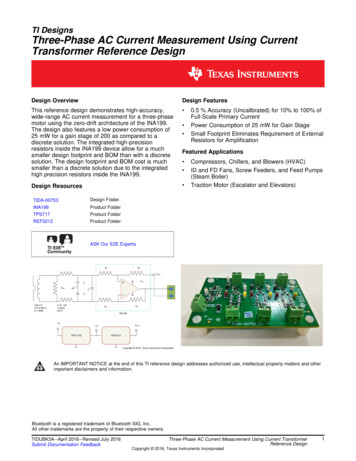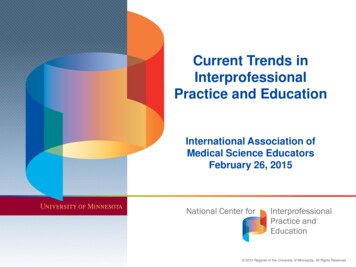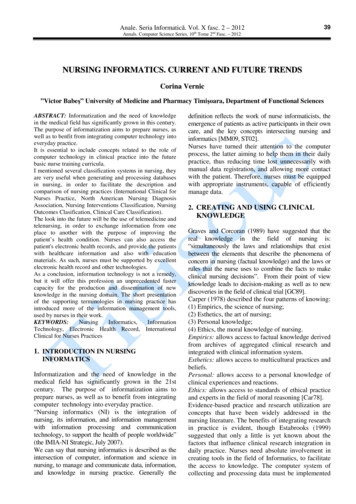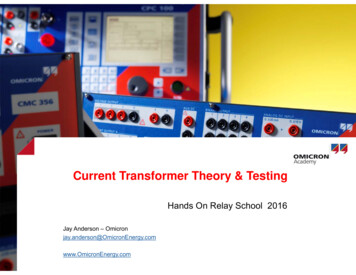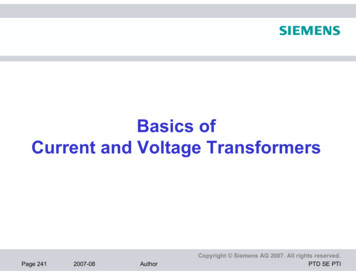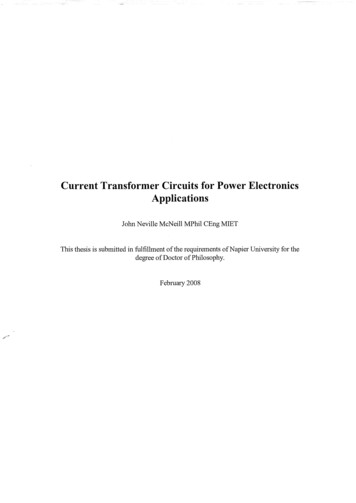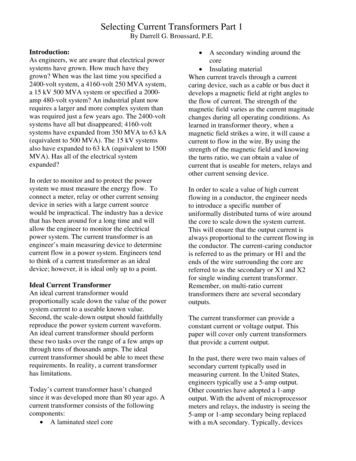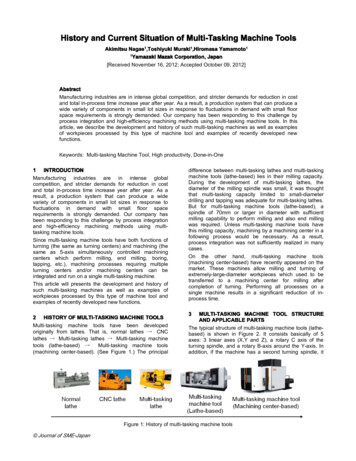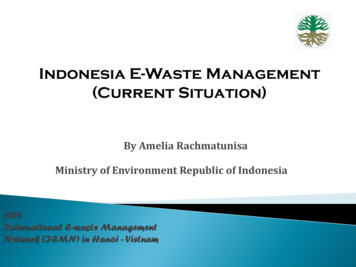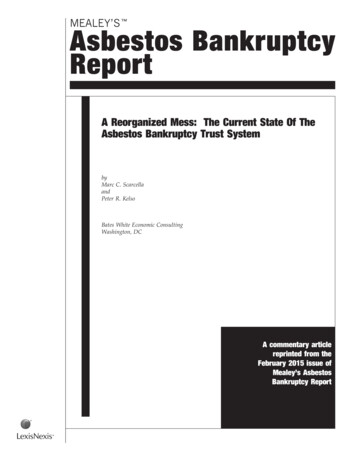
Transcription
MEALEY’STMAsbestos BankruptcyReportA Reorganized Mess: The Current State Of TheAsbestos Bankruptcy Trust SystembyMarc C. ScarcellaandPeter R. KelsoBates White Economic ConsultingWashington, DCA commentary articlereprinted from theFebruary 2015 issue ofMealey’s AsbestosBankruptcy Report
MEALEY’S Asbestos Bankruptcy ReportVol. 14, #7 February 2015CommentaryA Reorganized Mess: The Current State Of The Asbestos BankruptcyTrust SystemByMarc C. ScarcellaandPeter R. Kelso[Editor’s Note: Marc C. Scarcella is a Principal andPeter R. Kelso is a Manager at the Washington, DC officeof Bates White Economic Consulting. Any commentary oropinions do not reflect the opinions of Bates White EconomicConsulting or LexisNexis, Mealey’s. # 2015 by Marc C.Scarcella and Peter R. Kelso. Responses are welcome.]IntroductionIn 2005, the Chairman of our firm, Dr. CharlesBates, testified before a United States Senate JudiciaryCommittee as to the long-term financial feasibilityof the proposed 140 billion federal asbestos trustfund (S. 852 Fairness in Asbestos Injury Resolution(FAIR) Act). In his testimony and associated report,Dr. Bates cautioned that the proposed claim qualification criteria of the FAIR Act established a lower compensable claim threshold for certain injury classesrelative to the tort system. As a result, he predictedthat the number of claims filed against the nationalfund would far exceed the levels one would expect byextrapolating the tort history. Therefore, in order forthe FAIR Act to be financial feasibility either 1) thefunding would need to be set to a level sufficient tocompensate all current and future claims based on theeconomic incentives created by the trust proceduresand qualification criteria, or 2) the trust proceduresand qualification criteria would need be more closelytailored to mimic the resolution and valuation processin the tort system from which the 140 billion inproposed funding was based. In general, ignoringsuch differences between the incentives of the tortsystem and those created by an administrative trustwould lead to an underestimate of the number ofexpected trust claims and would result in the premature insolvency of the fund decades prior to itsintended duration.1 Though the FAIR Act failed topass in 2006, nearly a decade later there are dozens ofindividual asbestos bankruptcy trusts that are operating under a similar procedural construct; and as Dr.Bates predicted in 2005 in relation to the FAIR Acttrust, many of these current asbestos trusts haveexperienced a dramatic, premature depletion of funds.Asbestos bankruptcy trust funds are intended to payinitial and future claims in an equitable manner decadesinto the future. However, due to the accelerated depletion of funds, many asbestos trust claimants receive onlyhalf as much today as compared to the amounts similarly situated claimants received from the same trustsjust six years ago. In fact, on April 28, 2014, the UNRAsbestos Disease Claims Trust filed a motion with theUnited States Bankruptcy Court for the Northern District of Illinois, requesting permission to terminateoperations in the year 2019; decades prior to the expected duration of the trust and forecasted compensableclaim filings. While the UNR trust termination represents the most extreme case of trust insolvency, theevents that led to the UNR trust motion for prematuretermination are indicative of the systemic flaws of thecurrent trust system and its procedural construct thatincentivizes the over filing and payment of tenuousclaims. The resulting disparate treatment between initialand future claimants raises concerns over the lack oftrust operational transparency, and whether or notthe procedural design of these trusts has resulted in asystem of ‘ Institutionalized Fraud’’2 that has led to theimproper depletion of funds and financial harm tothose plaintiffs that are the most impaired.1
Vol. 14, #7 February 2015The following commentary will illustrate how the statusquo trust procedural construct is flawed, resulting inan adverse treatment of future claimants, and similarlyplacing those trusts at the risk of premature insolvency.Additionally, the commentary will demonstrate thatthe continued inequitable treatment of current andfuture claimants necessitates a change in the proceduresgoverning these trusts, and at the very least requires agreater level of trust operational transparency.3Trusts Continue to Reduce Their Net Payouts toIndividual ClaimantsAsbestos bankruptcy under section 524(g) of theU.S. bankruptcy code is unique compared to traditional chapter 11 reorganizations in that a majority ofthe creditors do not exist at the time of confirmation.The latent nature of asbestos-related injuries, wherethe diagnosis of an asbestos-related disease can occurdecades after exposure, creates a future creditor classof claimants that is unknown in terms of both quantity and compensable value at the time of bankruptcy.Nevertheless, the basic principle of 524(g) reorganization and bankruptcy in general, is that claimantswithin the same creditor class be treated in an equitable manner. Therefore, bankruptcy courts allow forthe estimation of future financial claim obligationsin order to determine a sufficient level of fundingnecessary to provide equitable treatment for bothinitial and future claims. However, the estimationprocess can only be effective if the eventual TrustDistribution Procedures (‘‘TDP’’) that govern thecompensability and valuation of claims are based onthe filing and resolution expectations that underliethe actual bankruptcy estimation forecasts. AnyFigure 1: The inequities of the THAN trust2MEALEY’S Asbestos Bankruptcy Reportdivergence between the forecasted value of futurefinancial obligations and the actual application ofthe trust administrative process will create shortfallsin funding to the detriment of future claimants.Possibly the most egregious example of inequitybetween initial and future asbestos claimants in a524(g) bankruptcy occurred during the reorganizationof T H Agriculture & Nutrition (‘‘THAN’’); the focusof our co-authored 2011 Mealey’s commentary titled‘‘Pre-Packaged Plan of Inequity: the financial abuseof future claimants in the T H Agriculture & Nutrition 524(g) asbestos bankruptcy.’’4 The commentarydetails the events that led to the THAN trust payinginitial claimants a 333% premium compared to futureclaimants. In short, the bankruptcy plan proponentsall assured the bankruptcy court that the 900 millionin proposed trust funding would be sufficient to payall current and future claims in an equitable manner.However, these assurances were supported by projections of future claim obligations that were not estimated based on the resolution and valuation criteriaset forth in the proposed THAN TDP. As a result, theTHAN trust immediately distributed close to 400million in negotiated claim obligations to pendingclaimants that voted in favor of the plan of reorganization (‘‘Asbestos PI Voting Claims’’). After the fact,THAN reduced the net payout available to futureclaimants to 30% the level of those initial AsbestosPI Voting Claims. Figure 1 illustrates the dramatic,and immediate inequity between initial and futureclaimants under the THAN plan of reorganizationand proceeding trust.
MEALEY’S Asbestos Bankruptcy ReportVol. 14, #7 February 2015payment to previously paid claimants equal to thedifference between what they previously receivedfrom the trust and what the trust is currently payingsimilarly situated claimants.The ability for the THAN trust to reduce net payoutsto future claimants was the result of a ‘‘Payment Percentage’’ mechanism that bankruptcy courts allowasbestos trusts to adopt in order to manage claimpayment distributions in the event that future financial expectations change over time. For example, iffuture liability expectations increase relative to assets,then trusts will likely decrease individual claim payments in an attempt to maintain sufficient assetsfor future claimants. Conversely, if future liability expectations decrease relative to assets, then trusts willlikely increase individual claim payments, and in mostinstances will provide a retroactive, or ‘‘True-Up’’Unfortunately for future claimants, recent history hasseen a dramatic decline in Payment Percentages. Forexample, currently there are 23 trusts that are payingclaimants less today than in 2008, and 11 of the 23 trustshave had to decrease the net claim payment amountmore than once.5 In contrast, only nine trusts are payingmore on a per claim basis today than in 2008. Figure 2summarizes these changes in Payment Percentages.Figure 2: Summary of Payment Percentage Changes since .4%17.4%17.4%API, ong World 7.5%7.5%7.5%7.5%0.5%0.5%0.5%0.5%Babcock & Wilcox34.0%34.0%15.0%15.0%11.9%7.5%7.5%7.5%C. E. Thurston & x612.0%14.1%14.1%9.4%9.4%9.4%6.5%6.5%Combustion 3%6.3%DII agle-Picher G-I Holdings (GAF)8.6%0.0%8.6%8.6%7.4%7.4%7.4%7.4%H.K. Porter4.6%4.6%6.3%6.3%6.3%4.0%4.0%3.0%J.T. Thorpe 0%J.T. Thorpe ser Aluminum & 1%1.1%1.1%0.8%0.8%0.8%0.8%0.8%Leslie Controls40.0%0.0%0.0%0.0%40.0%40.0%40.0%5.0%Lummus 0.0%7.5%7.5%7.5%7.5%7.5%7.5%6.3%National Gypsum855.6%55.6%55.6%55.6%18.0%18.0%18.0%18.0%OCF - Fibreboard25.0%25.0%11.0%11.0%9.5%7.6%7.6%7.6%OCF- Owens 5%8.5%8.5%1.2%1.0%1.0%1.0%Keene Creditors 8%Shook & Fletcher65.0%100%100%100%100%70.0%70.0%70.0%T H Agriculture & e Insulation Company17.5%0.0%0.0%17.5%17.5%17.5%30.5%30.5%U.S. 18.6%1.1%1.1%1.2%0.8%0.8%0.8%0.3%U.S. tern .0%48.0%*Amendments to trust distribution procedures increasing gross payment values in conjunction with, or in lieu of a PaymentPercentage change. See endnote for more detail.3
MEALEY’S Asbestos Bankruptcy ReportVol. 14, #7 February 2015To quantify the impact these changes in Payment Percentages can have on net claim payments, Figure 3summarizes the net claim payment for 6 large trusts(8 potential payments) that were processing and payingclaims at the Delaware Claims Processing Facility(‘‘DCPF’’) as of 2008. Even with the ArmstrongWorld Industries trust increasing its net payout bymore than 75%, the overall payout to a mesotheliomaclaimant collecting all 8 potential payments across the6 trusts is 46% lower as of yearend 2013 compared toyearend 2008.The experience of the DCPF trusts is consistent withthe trust system as a whole. As previously described, thePayment Percentage is a function of relative expectations for both future assets and liabilities. For example,the UNR trust not only experienced an increase intenuous claim filings, but the trust’s investment in thereorganized debtor also lost significant value over timeleading to lower than expected available assets. However, as we detail below, in most instances a decrease inPayment Percentage is primarily due to higher thanprojected claiming and resolution rates rather thanfinancially-driven factors, even during significant periods of economic recession.The Current Financial Standing of BankruptcyTrustsPrior to 2006 the trust system was a relatively minorsource of plaintiff compensation as there were only ahandful of active trusts, with total assets of less than 8 billion. However, since 2006 more than 30 trustshave been created through bankruptcy reorganization,funding the trust system with more than 23 billionin assets and yielding 17 billion in plaintiff compensation. In 2013 alone, the trust system received morethan 1.5 billion in additional funding, the highestlevel of new funds received since 2009.A majority of the 2013 funding resulted from theresolution of appeals to the confirmation plans proposed in the A.P. Green, North American Refractory(NARCO), and Thorpe Insulation bankruptcies.10 In2014, the confirmations of Pittsburgh Corning, W.R.Grace, Specialty Products Holdings, Metex, Quigley,and Flintkote will provide more than 8 billion inadditional funding that was still pending as of yearend2013. Figure 4 illustrates the annual assets of the trustcompensation system.In addition to direct funding from debtor contributionsand insurance settlements, the trust system has alsoearned 6.6 billion on its investments since 2006(4.1% annual return), which includes significant lossesin 2008 during the stock market recession. Betweeninvestment income and capital gains, the 6.6 billionin earnings and asset appreciation since 2006 has offsetnearly 40% of the claim payments made over thesame period. In fact, in 2012 the trust system earnedmore in investment income and capital gains than waspaid out to claimants. Figure 5 summarizes the financialactivity of the trust system since 2006.Figure 3: Net Mesothelioma Claim Payments from DCPF trusts (dollars in 212/312013Armstrong World Industries 26 26 26 26 26 46Babcock & Wilcox Company 41 18 18 14 9 9Celotex 18 18 12 12 12 8DII Industries - Halliburton 29 40 40 40 40 27DII Industries - Harbison-Walker 68 96 96 96 96 65OCF - Fibreboard 45 20 20 17 14 14OCF- Owens Corning 108 27 27 27 24 24U.S. Gypsum 101 101 68 68 45 45 437 346 306 300 265 238--21%30%31%39%46%Total Net PaymentPercent Change from 2008412/312009
MEALEY’S Asbestos Bankruptcy ReportVol. 14, #7 February 2015Figure 4: Trust Yearend AssetsFigure 5: Confirmed Trust Annual Financial Activity11 (dollars in inningAssets 7,641 21,217 23,116 18,662 19,910 18,817 17,992 18,083FundingReceived 13,305 2,928 988 3,104 584 706 208 1,586 23,408BalanceInvestmentGains/Income15Total 897 670( 1,971) 2,363 1,313 764 1,450 1,106 6,592ClaimPayments( 463)( 1,450)( 3,360)( 3,927)( 2,779)( 2,037)( 1,244)( 1,737)( 16,996)TrustExpenses( 95)( 132)( 156)( 147)( 180)( 176)( 173)( 221)( 1,279)Taxes/OtherDeductions( 68)( 117) 44( 145)( 30)( 82)( 151)( 330)( 879) 21,217 23,116 18,662 19,910 18,817 17,992 18,083 18,487Ending Assets16 160Current Confirmed Trust Assets 18,647Deferred fundingFrom a high level, the trust system appears to be earninga reasonable rate of return, especially considering thatmost trust agreements mandate a relatively conservativeinvestment strategy geared towards asset preservation asopposed to high growth. Figure 6 summarizes theweighted-average asset allocation from 2007 through2013 for 15 of the largest trusts as measured by totalfair market value of investments as of yearend 2013.17The 2013 fair market value of investments totaled over 15 billion across the 15 trusts, representing more than80% of confirmed trust assets. The data indicates thattrusts allocate a majority of assets in conservative fixedincome holdings as opposed to equities that are subjectto more potential volatility.The data illustrated in Figure 6 also shows that whilemany trusts emerge from bankruptcy with significantequity in the reorganized debtor, most of those sharesare liquidated following confirmation, which in turnhelps to diversify the overall trust portfolio andminimize risk; a strategy that may have helped theUNR trust, assuming the liquidation of the reorganized debtor stock was a viable option in the late1990s. Therefore, from an investment perspective,most current trusts clearly take a conservative approach to asset management. However, as importantas a reasonable return on investment is to the trusts,the long-term financial viability of any individualtrust, and the trust system as a whole, is even more5
MEALEY’S Asbestos Bankruptcy ReportVol. 14, #7 February 2015Figure 6: Trust average asset allocation from 2007 through 2013dependent on the proper liability management andprocedural standards surrounding the distribution ofclaim payments.It’s Not the Economy, It’s the ClaimsDespite the recent trend of declining Payment Percentages that yield significant payment reductions totoday’s similarly situated claimants, many of the individual trusts rarely disclose any meaningful, publicexplanation for the decrease. Rather most trustschoose to provide only vague public notices of thechange, with little to no justification. To that end, ithas been a common misconception in recent yearsthat the stock market recession of late 2008 andearly 2009 was the primary reason why so many trustssubsequently decreased their Payment Percentages.However, the actual experience of most trusts bothduring and following the 2008 stock market recessioncontradicts this notion.As the previous section showed, while the recessioncertainly created a temporary loss in trust assets, thesubsequent recovery has yielded an average annualreturn of 7.5% since 2009 across the entire trust system. In fact, the individual trust that was impactedthe most by the 2008 stock market recession was theArmstrong World Industries (AWI) Asbestos PI Settlement Trust, which held roughly two-thirds of itsassets (nearly 1.5 billion) as of yearend 2007 in thereorganized debtor’s stock. As of yearend 2008, thereorganized AWI stock value was nearly 45% less thanit had been the year before.18 Fortunately the stockrecovered the following year and continued to grow6in subsequent years, yielding substantial dividenddistributions to the trust. In fact, the recovery andsustained growth of the Armstrong stock more thanmade up for the previous losses and allowed the trustto increase its Payment Percentage from 20% to 35%in 2013. However, what’s more significant aboutthe experience of AWI is that the trust never loweredits Payment Percentage despite its temporary, albeitsubstantial, loss in asset value.A second trust that was heavily impacted by the 2008stock market recession was the Owens Corning subfund of the Owens Corning/Fibreboard (‘‘OCF’’)Asbestos PI Trust. The OCF trust was confirmed inSeptember 2006, and the Owens Corning subfundwas provided with approximately 3.4 billion in present value assets, which included 28.2 million sharesof reorganized Owens Corning common stock valuedat 820 million on the date of transfer to the trust. ByMay 31, 2009 the trust had incurred unrealized lossesof roughly 440 million of the stock’s original transfervalue, plus an estimated 330 million in additionalunrealized losses from other equity and bond investments.19 This substantial unrealized loss of approximately 770 million was likely further magnified byan expectation that the trust assets would have experienced a modest return on investment during its first30 months of operations rather than a significant loss.Overall, the temporary, yet substantial investmentloss likely cost the Owens Corning subfund approximately 1 billion of its initial present value of 3.4billion ( 30%). Therefore, when the trustees decided
MEALEY’S Asbestos Bankruptcy Reportto adopt a new Payment Percentage in June 2009, theinitial Payment Percentage of 40% should have beendecreased to approximately 28% had the stock marketrecession been the only factor leading to the reduction. Instead, the trust reduced the Payment Percentage to just 10%; proving that the stock marketrecession was not the primary factor that drove thereduction in Payment Percentage. In fact, if the dramatic decline in Payment Percentage was primarilydue to a stock market recession, then the OwensCorning subfun
of the proposed 140 billion federal asbestos trust fund (S. 852 Fairness in Asbestos Injury Resolution (FAIR) Act). In his testimony and associated report, Dr.Batescautioned thattheproposedclaimqualifica-tion criteria of the FAIR Act established a lower com-pensable claim threshol
